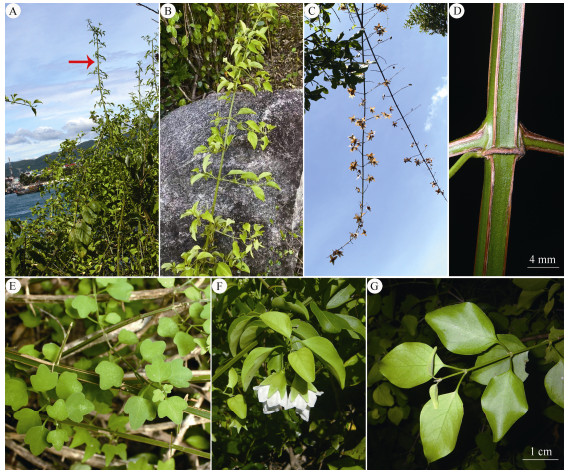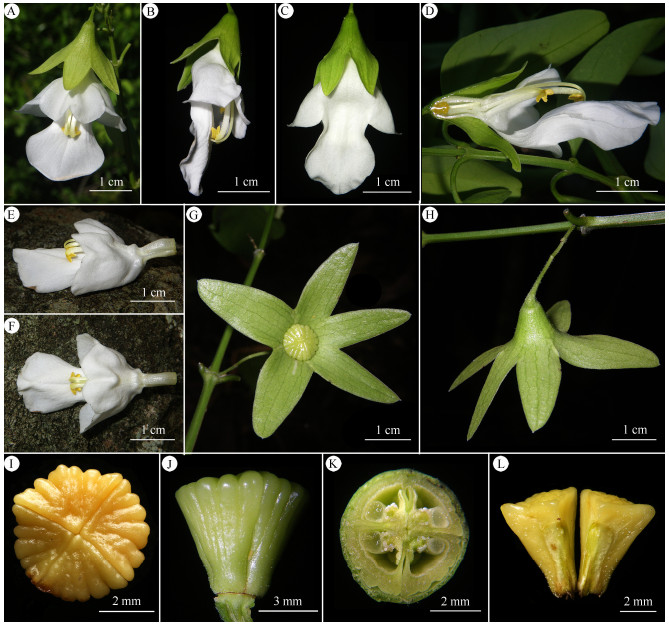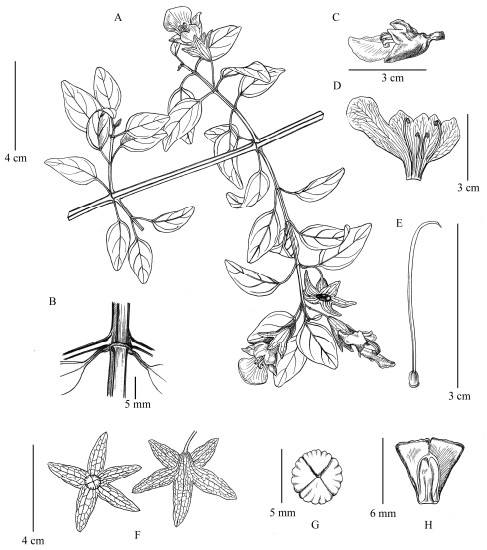2. Silviculture Research Institute, Vietnamese Academy of Forest Sciences, Hanoi 10000, Vietnam;
3. Joint Russian-Vietnamese Tropical Scientific and Technological Center, Hanoi 122000, Vietnam;
4. Department of Higher Plants, Biological Faculty, M.V. Lomonosov Moscow State University, Moscow 119234, Russia;
5. Institute of Geography, Vietnam Academy of Science and Technology, Hanoi 10000, Vietnam;
6. 中国科学院昆明植物研究所, 昆明 650201
2. Silviculture Research Institute, Vietnamese Academy of Forest Sciences, Hanoi 10000, Vietnam;
3. Joint Russian-Vietnamese Tropical Scientific and Technological Center, Hanoi 122000, Vietnam;
4. Department of Higher Plants, Biological Faculty, M.V. Lomonosov Moscow State University, Moscow 119234, Russia;
5. Institute of Geography, Vietnam Academy of Science and Technology, Hanoi 10000, Vietnam;
6. Key Laboratory for Plant Diversity and Biogeography of East Asia, Kunming Institute of Botany, Chinese Academy of Sciences, Kunming 650201, China
自2016年起,笔者开始与越南同行合作开展越南唇形科植物分类学研究,先后发现新物种越南豆腐柴(Premna vietnamensis Bo Li[1]、香简草(Elsholtzia kachinensis Prain)和保亭花(Wenchengia alternifolia C.Y. Wu & S. Chow)在越南的分布新资料等[2–3]。在整理越南唇形科分类学文献资料时, An Illustrated Flora of Vietnam[4]中所记载的第7393号物种引起了笔者的强烈关注。该种被鉴定为膜萼藤属(Hymenopyramis Wall. ex Griff.)一未知种。通常而言,膜萼藤属物种具有顶生或腋生的聚伞圆锥花序、花微小(长不足5 mm)、花冠漏斗状、4枚花冠裂片自喉部开展、花萼钟状、具4个小齿或浅裂、在果期增大呈透明的囊状而完全包裹果实[5–6]。但从该物种的插图和描述看,其单花腋生、花大型(长4~6 cm)、花冠明显二唇形且具5枚花冠裂片、花萼5深裂、裂片近辐射对称且在果期增大并开展等特征与膜萼藤属的形态差异巨大。
为进一步明确该未知物种的真实身份,我们广泛检索了各类文献资料和网络在线资源,尤其是基于Pham-Hoang[4]所记载的原始分布地点“Cầuđá, Nhatrang [笔者注:芽庄市,越南庆和省(Khanh Hoa Province)首府]”而将检索区域重点聚焦在越南中南部沿海各省,最终在宁顺省(Ninh Thuan Province)主山国家公园(Nui Chua National Park)官网上查阅到了两张该物种的野外照片(http://vqgnuichua.vn/Upload/thuvienanh/DDS_14532_Hymenopyramis_04.JPG; http://vqgnuichua.vn/Upload/thuvienanh/DDS_14532_Hymenopyramis_10.JPG),并在法国自然历史博物馆(Muséum National d’Histoire Naturelle)标本馆中检索到2010年采自该国家公园的1份标本(http://coldb.mnhn.fr/catalognumber/mnhn/p/p03977758),二者均被鉴定为“Hymenopyramis sp.”。上述照片和标本的发现为我们在野外采集该物种提供了重要线索。
2021年,Maxim S. Nuraliev等在开展越南植物区系与植物多样性研究时,在芽庄市珍珠岛(Hon Tre Island)发现了该种的野生居群,并分别采集了标本及分子材料。2022年,Thanh Son Hoang等相继在平定省(Binh Dinh Province)和富安省(Phu Yen Province)海岸边发现了该种大量野生居群。2022年7月至9月,当第一作者李波博士陆续收到采自庆和省和平定省的标本实物时,确认该未知种并非膜萼藤属成员,并据其果实表面有显著的放射状瘤状突起(果实表面具瘤状或翅状突起是黄芩亚科的共衍征之一[7])而推测该种与黄芩亚科存在明显联系。这一推测进而得到了通讯作者向春雷博士实验室叶绿体系统发育基因组学分析结果的支持,确定其与冬红属(Holmskioldia Retz.)构成高支持率的姊妹群关系(未发表数据)。综合考虑形态学和分子系统学研究证据,确定该物种为唇形科黄芩亚科一未被描述的新属,即日轮果属(Heliacria Bo Li, C.L. Xiang, T.S. Hoang & Nuraliev),本文特此报道。
1 材料和方法形态描述依据Maxim S. Nuraliev和Thanh Son Hoang采集的标本及拍摄的野外照片,墨线图的绘制参照Maxim S. Nuraliev NUR 3358号标本,使用直尺和游标卡尺进行性状测量,分布地点基于文献和标本采集信息及野外观察记录。凭证标本分别存放在中国科学院华南植物园标本馆(Herbarium of South China Botanical Garden, Chinese Academy of Sciences, IBSC)、中国科学院昆明植物研究所标本馆(Herbarium of Kunming Institute of Botany, Chinese Academy of Sciences, KUN)、中国科学院西双版纳热带植物园标本馆(Herbarium of Xishuangbanna Tropical Botanical Garden, Chinese Academy of Sciences, HITBC)、上海辰山植物园标本馆(Herbarium of Shanghai Chenshan Botanical Garden, CSH)、莫斯科国立米哈伊尔·瓦西里耶维奇·罗蒙诺索夫大学标本馆(Herbarium of M.V. Lomonosov Moscow State University, MW)和越南林业科学院标本馆(Herbarium of Vietnamese Academy of Forest Sciences, VAFS)。
2 结果日轮果属(黄芩亚科) 新属
Heliacria Bo Li, C.L. Xiang, T.S. Hoang & Nuraliev, gen. nov. (subfamily Scutellarioideae)
Type: Heliacria maritima Bo Li, C.L. Xiang, T.S. Hoang & Nuraliev
Diagnosis: Heliacria is a distinct genus within the subfamily Scutellarioideae of Lamiaceae, which differs from the five other currently recognized genera of the subfamily by large flowers with pure white corolla, sub-actinomorphic calyx with five long lobes which are accrescent and spreading in fruits, strongly 2-lipped corolla with a relatively short tube, abruptly inflated corolla throat, median lobe of lower corolla lip much larger than its lateral lobes and than lobes of upper lip, obconical fruit splitting into 4 irregularly tetrahedral nutlets, and nutlets radially tuberculate at apex. Heliacria is most closely related to Holmskioldia according to the phylogenomic analysis of Lamiaceae (C.L. Xiang, unpublished data) but is readily distinguished from the latter morphologically as indicated above.
Etymology: The generic name Heliacria is derived from the Greek Helios (which means Sun) and acros (which means apical), referring to the nutlets that are radially tuberculate at apex.
Note: Heliacria is a monotypic genus currently known to be endemic to Vietnam.
日轮果属因具攀援藤本习性;花冠大、显著二唇形、冠筒为纯白色且冠筒短而弯曲、在喉部急剧膨大成囊状、花冠下唇中裂片显著大于其他裂片; 花萼近辐射对称、5深裂、裂片长且在果期增大并开展;果实为倒圆锥状且完全分裂为4个小坚果, 果实顶端具放射状的瘤状突起而明显区别于黄芩亚科其他5属。叶绿体系统发育基因组学分析结果显示日轮果属与冬红属为姊妹群(未发表数据),但二者存在上述一系列明显形态特征差异而极易区分。
日轮果属的名称意指该属果实顶端具放射状的瘤状突起,形似行星齿轮系传动装置中的外齿轮形象,即太阳轮。
该属仅包含日轮果一种,目前仅知特产于越南。

|
图 1 日轮果生境及外部形态特征。A: 生境, 箭头示植株; B: 植株形态; C: 果枝; D: 茎; E: 幼叶三浅裂; F: 花序; G: 成熟叶片。(照片由Thanh Son Hoang和Maxim S. Nuraliev提供) Fig. 1 Habitat and morphology of Heliacria maritima. A: Habitat, the red arrow showing an individual; B: Habit; C: Fruiting branches; D: Stem; E: Leaves (shallowly 3-lobed) on young shoots; F: Inflorescences; G: Leaves on old branches. (Photo by Thanh Son Hoang and Maxim S. Nuraliev) |

|
图 2 日轮果花果形态特征。A: 花, 顶面观; B: 花, 侧面观; C: 花, 背面观; D: 花冠管、雄蕊和花柱; E: 花冠, 侧面观; F: 花冠, 顶面观; G: 花萼和果实; H: 花萼, 侧面观; I: 成熟果实, 顶面观; J: 幼果, 侧面观; K: 子房横切面; L: 小坚果及合生面。(照片由Thanh Son Hoang和Maxim S. Nuraliev提供) Fig. 2 Flower and fruit in Heliacria maritima. A–C: Flower (adaxial, lateral, abaxial view, respectively); D: Longitudinally dissected flower; E, F: Fallen corolla (lateral and adaxial view); G: Fruit with persistent calyx; H: Fruiting calyx in lateral view; I: Mature fruit in apical view, showing radial tubercules; J: Young fruit in lateral view, showing longitudinal ridges; K: Cross section of young fruit; L: Nutlets, showing attachment-scars. (Photoed by Thanh Son Hoang and Maxim S. Nuraliev) |

|
图 3 日轮果墨线图。A: 花枝; B: 茎; C: 花冠, 侧面观; D: 花冠展开, 示雄蕊; E: 子房和花柱; F: 花萼; G: 果实顶面观; H: 小坚果合生面。(刘运笑根据主模式NUR 3358绘制) Fig. 3 Line drawing of Heliacria maritima. A: Flowering branches; B: Node of shoot; C: Corolla in lateral view; D: Dissected corolla, showing stamens; E: Ovary and style; F: Fruit with persistent calyx; G: Fruit in apical view; H: Nutlets, showing attachment-scars. (Illustrated by YunXiao Liu based on the holotype NUR 3358) |
Heliacria maritima Bo Li, C.L. Xiang, T.S. Hoang & Nuraliev, sp. nov. Figs. 1–3.
Type: VIETNAM. Khanh Hoa Province: Nha Trang City, Hon Tre Island, near Dam Bai marine climate station, growing in disturbed low coastal forests, 109°17′11″ E, 12°11′29″ N, elev. ca. 50 m a.s.l., 28 May 2021, Maxim S. Nuraliev, NUR 3358 [holotype: IBSC (barcode No. 0896075!), isotypes: KUN: (barcode No. 1580435!), MW: (barcode No. MW0595841!)].
Description: Woody climbers or scandent shrubs, evergreen, 0.5–5 m long. Shoot erect or ascending when young but scandent when mature, often drooping gracefully to the ground, branching at nearly right angle. Branches distinctly 4-angled in cross section with obviously thickened to slightly winged ridges, green with brown ridges, glabrescent; branchlets slender, minutely pubescent when young, subglab-rescent. Mature nodes with light brown interpetiolar ridges covered with dense short hairs. Leaves opposite, simple; petiole 0.8–1.7 cm long, pubescent when young, glabrescent; leaf blade papery, entire on mature shoots, mostly shallowly 3-lobed on young shoots, ovate to indistinctly rhombic, 2.3–5.5 cm× 1.2–2.8 cm, hairy when young but completely glabrescent on both sides, base broadly truncate, apex obtuse and shallowly emarginate (and sometimes with a small apical mucro), lateral vein 3–4 pairs, adaxially flat, abaxially slightly raised. Inflorescence a pendulous axillary cyme, usually 1-flowered, rarely 2- or 3- flowered; peduncles up to 0.5 cm long, sparsely pubescent; pedicels 0.9–1.8 cm long, sparsely pubescent; bracteoles minute, linear, caducous. Calyx light green, campanulate, sub-actinomorphic, 1.3–1.9 cm long, papery, sparsely hairy outside (abaxially), densely minutely hairy inside (adaxially), covered with numerous yellow sessile glands, densely net-veined with 10 primary veins, 5-lobed to almost 1/2 of length; tube funnel-shaped, 4–6 mm long; lobes subequal, train-gular, acute at apex, 0.9–1.3 cm long, 0.6–0.8 cm wide at base; calyx persistent in fruits, 3.8–4.3 cm in diameter apically with lobes becoming spreading and accrescent to 1.9 cm long (fruiting calyx in shape of slightly zygomorphic star). Corolla pure white, zygomorphic, strongly 2-lipped, tubular-infundibular, 3.3– 4.2 cm long; tube ca. 0.6 cm long, 4 mm wide at base, abruptly dilated to 1.2 cm wide at throat, sparsely minutely glandular pubescent outside; lips glabrous; upper (adaxial) lip 2-lobed, lobes triangular-ovate, equal, 0.5–0.8 cm×0.7–0.9 cm; lower (abaxial) lip 3-lobed, lobes unequal, median lobe straight and erect, subelliptic to oblong-obovate, 1.6–1.9 cm long, 1.6–1.8 cm wide at the widest place, lateral lobes at right angle to median lobe (vertically oriented), nearly erect to recurved backwards, semicircular, 0.6 cm long and wide. Stamens 4, didynamous, appressed to adaxial side of corolla; filaments attached to corolla throat or slightly below, white, distinctly arcuate towards apex, glandular-pubescent near apex; posterior stamens exerted from the upper corolla lip, 1.7–1.9 cm long; anterior stamens included in corolla throat, ca. 1.2 cm long; anthers dorsifixed, yellow, with prominent connective, V-shaped (with divergent thecae), dehiscent longitudinally. Ovary superior, yellow, nearly cylindrical, about 3 mm long and wide, glabrous, covered with scattered white sessile glands (more densely so towards base), longitudinally 4-lobed, each lobe 1-ovuled. Style subterminal (placed at center of ovary between its lobes), exerted from the upper corolla lip (reaching anthers of posterior stamens), white and apically slightly yellowish, 2.1–2.4 cm long, glabrous, curved downwards at apex; stigma unequally 2-cleft with stigma lobes ca. 2 mm long. Fruit deeply enclosed by calyx tube, green when young but brown when mature, obconical, glabrous, with radially tuberculate flat upper surface, completely splitting into 4 nutlets; nutlets dry, irregularly tetrahedral, ca. 6 mm long, outer side longitudinally ridged; attachment-scar lateral, ca. 2/3 as long as nutlet.
Phenology: Flowering and fruiting is recorded in January, May, June, and July. We suppose that the species is flowering and fruiting nearly all year round.
Etymology: The specific epithet “maritima” refers to the ecological preferences of the new species, which is confined to the specific coastal vegetation.
Distribution and habitat: The new species is currently known from Binh Dinh, Phu Yen, Khanh Hoa, and Ninh Thuan provinces of Vietnam (Fig. 4). It is confined to low and dry spiny coastal forests and shrubby vegetation, occurring up to 250 m a.s.l. Based on its occurrences and habitat, we suppose that the species is widely distributed in the coastal areas of south-central Vietnam.

|
图 4 日轮果在越南的地理分布(红色五角星示) Fig. 4 Distribution map of Heliacria maritima (known locations are marked by red stars) |
Additional specimens examined (paratypes): VIETNAM. Binh Dinh Province: Phu My District, My Thanh Commune, Vinh Loi Village, semi-deciduous thorny scrubs on coastal sandy hill, 109°12′12′′ E, 14° 07′50′′ N, elev. ca. 10 m a.s.l., 5 July 2022, Vu Anh Tai & Thanh Son Hoang, VAFS05072022 (VAFS!); Khanh Hoa Province: Nha Trang City, Hon Tre Island, territory of Dam Bai Marine Climate Station, disturbed margin of forest, not far from seashore, 109°17′27′′ E, 12°11′52′′ N, elev. ca. 30 m a.s.l., 22 May 2021, Maxim S. Nuraliev, NUR 3295 [CSH: (barcode No. CSH0198329!), MW: (barcode No. MW0595842!, MW0595843!), HITBC: (barcode No. HITBC0094275!)]; Ninh Thuan Province: Ninh Hai District, Nui Chua National Park, Botanical Garden, E slope, at Vung Olim Campsite, dry forests on the eastern flange of the Cotuy Range, 109°11′10′′ E, 11°42′48′′ N, elev. 100 m a.s.l., 8 January 2010, D. Djendoel Soejarto, N.T. Trung, T.N. Ninh & T.T. Trinh, DDS_14532 [P: (barcode No. P03977758!)].
Other field records: Phu Yen Province: Tuy Hoa City, 3 June 2023, Thanh Son Hoang, s.n. (photo LE: LE01093262!); VIETNAM. Khanh Hoa Province: Nha Trang City, Hon Tre Island, near Dam Bai Marine Climate Station, in dry low forests on slope, not far from seashore, 109°17′20′′ E, 12°11′35′′ N, elev. ca. 40 m a.s.l., 7 January 2021, Maxim S. Nuraliev & Dmitry F. Lyskov, NUR 3072b (photos LE: LE01093260!); bushland on plakor near dirt road, 109°16′52′′ E, 12° 11′38′′ N, elev. 220 m a.s.l., 28 May 2021, Maxim S. Nuraliev, NUR 3358a (photos LE: LE01093261!).
Conservation status: Based on the wide distribution of Heliacria maritima in coastal forests of south-central Vietnam discussed above and no significant threats observed for the documented populations, we provisionally assess the conservation status of the species as “Least Concern” (LC) according to the IUCN Red List categories and criteria[8].
常绿攀缘状灌木,高0.5~5 m。茎幼时直立或斜升,老时攀缘,常披散,悬垂地面,明显四棱形且棱显著增厚或略呈翅状。老枝绿色但棱为棕色, 小枝近直角展开,柔毛渐脱落至光滑。小枝细弱, 被细柔毛至近无毛。节密被细柔毛,具横向、浅棕色的叶柄缝隙联合线。单叶对生,叶柄长0.8~1.7 cm, 疏被柔毛。叶片纸质,倒卵形至略微菱形,长2.3~5.5 cm, 宽1.2~2.8 cm,幼时3浅裂或全缘,疏被柔毛,老时渐脱落至完全无毛,叶基宽楔形,叶尖钝或偶为渐尖,近全缘或偶微缺刻,侧脉3~4对,在下面较为明显。腋生聚伞花序常具单花或偶为3花;花序梗短,长不过0.5 cm,被疏柔毛;花梗长0.9~1.8 cm, 被疏柔毛;小苞片早落,微小,线形。花萼钟状, 浅绿色,近辐射对称,长1.3~1.9 cm,纸质,外面疏被细柔毛,内面更密,具10条主脉,网脉细密而明显;萼筒短漏斗状,长0.4~0.6 cm;萼齿裂至花萼1/2处,裂片近相等,窄倒卵形至披针形,长0.9~1.3 cm,基部宽0.6~0.8 cm;花萼果期宿存,萼片明显增大,直径3.8~4.3 cm,萼片开展,长可达1.9 cm。花冠纯白色,明显二唇形,管状漏斗形,长3.3~4.2 cm;冠筒短而细,长约0.6 cm,基部宽约0.4 cm,在喉部急剧扩大呈囊状,宽约1.2 cm,外面疏被细小腺毛;上唇2裂,裂片等大,宽卵圆形,长0.5~0.8 cm,宽0.7~0.9 cm;下唇3裂,中裂片最大, 近椭圆形至椭圆状倒卵形,长1.6~1.9 cm, 最宽处宽1.6~1.8 cm,侧裂片与中裂片近直角,直立或后弯,半圆形。雄蕊4,二强雄蕊,花丝生于花冠喉部或略低位置,急剧地向上膝状弯曲,花丝顶部被腺毛; 后对雄蕊自花冠上唇伸出,长1.7~1.9 cm; 前对雄蕊内藏,长约1.2 cm;花药背着,黄色,药室“V型”叉开,纵裂。子房上位,黄色,圆柱形, 长约0.3 cm,疏被白色、无柄的盾状腺毛,4室,每室具1胚珠。花柱近顶生,自花冠上唇伸出,与上对雄蕊近等长,长2.1~2.4 cm,无毛,顶部略带黄色,向下弯曲; 柱头为不等2裂,裂片长约2 mm。果实几乎被萼管所包藏,倒圆锥状,无毛,顶端截平,轮廓圆形, 具放射状排列的瘤状突起,成熟时完全分裂为4枚小坚果;小坚果幼时绿色,成熟时棕色,干燥,呈不规则四面体状,长约6 mm,外侧面具纵棱脊;合生面约长达小坚果长度的三分之二(图 1~3)。
基于标本信息和我们的野外观察数据,发现采自1月、5月、6月和7月的标本都是盛花且有果的状态,故推测日轮果有可能是全年开花结果。
越南:庆和省,芽庄市,珍珠岛,海岸边低地矮林,东经109°17′11′′ E,北纬12°11′29′′ N,海拔约50 m,2021年5月28日,Maxim S. Nuraliev, NUR 3358 (主模式:中国科学院华南植物园标本馆, IBSC, 0896075!;等模式:中国科学院昆明植物研究所标本馆,KUN, 1580435!;莫斯科国立米哈伊尔·瓦西里耶维奇·罗蒙诺索夫大学标本馆,MW, MW0595841!)。
种加词“maritima”意指其生长于海岸边低地矮林中的特殊生境。据目前所知,日轮果仅发现于越南东南沿海的平定省、富安省、庆和省和宁顺省。尽管周边省份类似生境中或许还有其他居群,但仍有待于进一步确认。就当前所掌握的信息而言,日轮果的居群并未受到明显可见的生存威胁。依据国际自然联盟红色名录评估标准,我们暂时将其濒危等级评估为“无危”[8]。
3 讨论黄芩亚科是唇形科12亚科之一[9–10],此前包括5属,即保亭花属(Wenchengia C.Y. Wu & S. Chow)、冬红属、瘤果梓属(Renschia Vatke)、黄芩属(Scutellaria L.)和火梓属(Tinnea Kotschy ex Hook. f.),其中前3属为单型属,黄芩属包含约300种,为该亚科最大的属,而火梓属包含约20种[11]。日轮果属的发现,使得该亚科的属数增加至6属。该亚科在形态上具有较高的多样性[12],但也存在两个易于识别的共衍征,即花萼具发达的网脉和小坚果具瘤状或翅状附属物[7,10],日轮果属的相关形态特征与此高度吻合。黄芩亚科的花萼总体上呈现出增大与联合的趋势,其中保亭花属和日轮果属花萼具有5枚裂片,冬红属花萼扩展为近辐射对称的圆盘,仅偶见5枚小齿[6],而黄芩属、瘤果梓属和火梓属的花萼则上下二唇完全联合为全缘[11]。相反,聚伞花序在该亚科有明显的简化趋势,即具3花的聚伞花序仅中央花发育而呈单花腋生状态,或进而由此构成总状花序或聚伞圆锥花序[7,9]。日轮果属和黄芩属及火梓属部分种类的花序表现为前者,而保亭花属、瘤果梓属和冬红属则为后者。花冠管形态在该亚科也存在两种状态,一类是花冠管为管状漏斗形,基部窄,中部弯曲,顶部扩大为喉部,明显长于花萼, 保亭花属、冬红属、黄芩属和瘤果梓属为此类形态; 另一类是花冠管短而直,喉部剧烈扩大,短于花萼, 日轮果属和火梓属花冠管则为此类型。地理分布上, 瘤果梓属和火梓属特产非洲,保亭花属、日轮果属和冬红属则特产东南亚热带亚热带地区,而黄芩属近全球分布[10,12]。日轮果属的发现为解析黄芩亚科的性状演化和生物地理格局成因提供了全新的视角(未发表数据)。
随着该新属的发表,黄芩亚科已增至6属,为方便检索,本文提供该亚科6属的检索表。
| 表 黄芩亚科各属检索表 Table Key to the genera of the subfamily Scutellarioideae |
致谢 感谢中国科学院华南植物园标本馆刘运笑女士绘制墨线图、上海辰山植物园刘夙博士提供命名法参考意见、中国科学院昆明植物研究所陈亚萍博士分享系统发育分析结果及审稿专家和责任编辑提供宝贵的修改意见。
| [1] |
HAI D V, MIN D Z, KHANG N S, et al. Premna vietnamensis (Lamiaceae, Premnoideae), a distinct new species from the central highlands of Vietnam[J]. PLoS One, 2018, 13(5): e0195811. DOI:10.1371/journal.pone.0195811 |
| [2] |
HOANG T S, MIN D Z, THOA T K, et al. First record of Elsholtzia kachinensis (Lamiaceae: Nepetoideae) for the Flora of Vietnam[J]. Phytotaxa, 2020, 430(1): 57-60. DOI:10.11646/phytotaxa.430.1.9 |
| [3] |
ZHOU Q Y, CAI H X, LIU Z H, et al. Development of genomic resources for Wenchengia alternifolia C.Y. Wu & S. Chow (Lamiaceae) based on genome skimming data[J]. Plant Divers, 2022, 44: 542-551. DOI:10.1016/j.pld.2021.09.006 |
| [4] |
PHAM-HOANG H. An Illustrated Flora of Vietnam, Vol. 2[M]. Ho Chi Minh: Youth Publishing House, 2003: 1-951.
|
| [5] |
QIU X H, FU G Y. Hymenopyramis, a newly recorded genus of Flora of China[J]. Trop For, 1986, 2: 53-54. 邱兴华, 符国瑗. 膜萼藤属, 中国植物区系一新记录属[J]. 热带林业科技, 1986, 2: 53-54. |
| [6] |
CHEN S L, GILBERT M G. Verbenaceae[M] // WU Z Y, RAVEN P H. Flora of China, Vol. 17. Beijing: Science Press & St. Louis: Missouri Botanical Garden Press, 1994: 1–49.
|
| [7] |
LI B, XU W X, TU T Y, et al. Phylogenetic position of Wenchengia (Lamiaceae): A taxonomically enigmatic and critically endangered genus[J]. Taxon, 2012, 61(2): 392-401. DOI:10.1002/tax.612010 |
| [8] |
IUCN Standards and Petitions Committee. Guidelines for using the IUCN Red List Categories and Criteria, Version 15[OL]. Prepared by the Standards and Petitions Committee. 2023. https://www.iucnredlist.org/resources/redlistguidelines.
|
| [9] |
LI B, CANTINO P D, OLMSTEAD R G, et al. A large-scale chloroplast phylogeny of the Lamiaceae sheds new light on its subfamilial classification[J]. Sci Rep, 2016, 6: 34343. DOI:10.1038/srep34343 |
| [10] |
ZHAO F, CHEN Y P, SALMAKI Y, et al. An updated tribal classification of Lamiaceae based on plastome phylogenomics[J]. BMC Biol, 2021, 19: 2. DOI:10.1186/s12915-020-00931-z |
| [11] |
HARLEY R M, ATKINS S, BUDANTSEV A L, et al. Labiatae[M]//KUBIZKI K, KADEREIT J W. Families and Genera of Vascular Plants. Vol. 7. Berlin: Springer, 2004: 167–275.
|
| [12] |
ZHAO F, LI B, DREW B T, et al. Leveraging plastomes for comparative analysis and phylogenomic inference within Scutellarioideae (Lamiaceae)[J]. PLoS One, 2020, 15(5): e0232602. DOI:10.1371/journal.pone.0232602 |
 2023, Vol. 31
2023, Vol. 31


